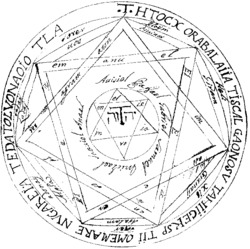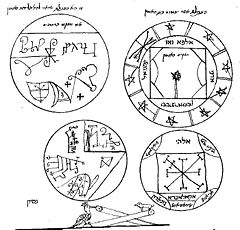- Key of Solomon
-
 One of the pentacles found in the "Key of Solomon" manuscripts. This one is identified as "The Great Pentacle" and appears in Bodleian Library Michael MS. 276, a 17th century Italian manuscript. An equivalent figure also appears in a Latin version, Bodleian Library, Aubrey MS. 24, dated to 1674. The figure is a variant of the Sigillum Aemeth published by Athanasius Kircher in Oedipus Aegyptiacus (Rome, 1652–4, pp. 479–81).
One of the pentacles found in the "Key of Solomon" manuscripts. This one is identified as "The Great Pentacle" and appears in Bodleian Library Michael MS. 276, a 17th century Italian manuscript. An equivalent figure also appears in a Latin version, Bodleian Library, Aubrey MS. 24, dated to 1674. The figure is a variant of the Sigillum Aemeth published by Athanasius Kircher in Oedipus Aegyptiacus (Rome, 1652–4, pp. 479–81).
The Key of Solomon (in Latin Clavis Salomonis or Clavicula Salomonis, Hebrew Mafteah Shelomoh (מפתח שלמה)), is a grimoire, or book on magic incorrectly attributed to King Solomon. It probably dates back to the 14th or 15th century Italian Renaissance. It presents a typical example of Renaissance magic.
It is possible that the Key of Solomon inspired later works, particularly the 17th century grimoire also known as Clavicula Salomonis or The Lesser Key of Solomon, although there are many differences between the books.
Contents
Manuscripts and textual history
Many such grimoires attributed to King Solomon were written in this period, ultimately influenced by earlier (High Medieval) works of Jewish kabbalists and Arab alchemists, which in turn hark back to Greco-Roman magic of Late Antiquity.
Several versions of the Key of Solomon exist, in various translations, and with minor or significant differences. The archetype was likely a Latin or Italian text dating to the 14th or 15th century.[1] Most extant manuscripts date to the late 16th, 17th or 18th centuries, but there is an early Greek manuscript, dating to the 15th century (Harleian MS. 5596) closely associated with the text. The Greek manuscript is referred to as The Magical Treatise of Solomon, and was published by Armand Delatte in Anecdota Atheniensia (Liége, 1927, pp. 397–445.) Its contents are very similar to the Clavicula, and it may in fact be the prototype on which the Italian or Latin text was based.
An important Italian manuscript is Bodleian Library Michael MS 276. An early Latin text survives in printed form, dated to ca. 1600 (University of Wisconsin-Madison, Memorial Library, Special Collections). There is a number of later (17th century) Latin manuscripts. One of the oldest extant manuscripts (besides Harleian 5596) is a text in English translation, entitled The Clavicle of Solomon, revealed by Ptolomy the Grecian and dated to 1572. There are a number of French manuscripts, all dated to the 18th century, with the exception of one dated to 1641 (P1641, ed. Dumas, 1980).
A Hebrew text survives in two versions, one kept at the British Library, on a parchment manuscript, separated in BL Oriental MSS 6360 and 14759. The BL manuscript was dated to the 16th century by its first editor Greenup (1912), but is now thought to be somewhat younger, dating to the 17th or 18th century.[2] The discovery of a second Hebrew text in the library of Samuel H. Gollancz was published by his son Hermann Gollancz in 1903, who also published a facsimile edition in 1914.[3] Gollancz' manuscript had been copied in Amsterdam, in Sephardic cursive script, and is less legible than the BL text. The Hebrew text is not considered the original. It is rather a late Jewish adaptation of a Latin or Italian Clavicula text. The BL manuscript is likely the archetype of the Hebrew translation, and Gollancz' manuscript a copy of the BL one.[2]
An edition of the Latin manuscripts of the British Library was published by S. L. MacGregor Mathers in 1889. L. W. de Laurence in 1914 published "The Greater Key of Solomon", directly based on Mathers' edition, to which he made alterations in an attempt to advertise his mail-order business (for example by inserting instructions like "after burning one-half teaspoonful of Temple Incense" along with ordering information for the incense).
Contents
Summary
The Key of Solomon is divided into two books. It describes not the appearance or work of any spirit but only the necessary drawings to prepare each "experiment" or, in more modern language, magical operations.
Unlike later grimoires such as the Pseudomonarchia Daemonum (16th century) or the Lemegeton (17th century ), the Key of Solomon does not mention the signature of the seventy-two spirits constrained by King Solomon in a bronze vessel. As in most medieval grimoires, all magical operations are ostensibly performed through the power of God, to whom all the invocations are addressed. Before any of these operations (termed "experiments") are performed, the operator must confess his sins and purge himself of evil, invoking the protection of God.
Elaborate preparations are necessary, and each of the numerous items used in the operator's "experiments" must be constructed of the appropriate materials obtained in the prescribed manner, at the appropriate astrological time, marked with a specific set of magical symbols, and blessed with its own specific words. All substances needed for the magic drawings and amulets are detailed, as well as the means to purify and prepare them. Many of the symbols incorporate the Transitus Fluvii occult alphabet.
Introduction
According to the mythical history of the document, as recorded in its introduction, Solomon wrote the book for his son Rehoboam, and commanded him to hide the book in his sepulchre upon his death. After many years the book was discovered by a group of Babylonian philosophers repairing Solomon's tomb. None could interpret the text, until one of them, Iohé Grevis, suggested that they should entreat the Lord for understanding. The Angel of the Lord appeared to him and extracted a promise that he would keep the text hidden from the unworthy and the wicked, after which he was able to read it plainly. Iohé Grevis then placed a conjuration on the book that the unworthy, the unwise or those who did not fear God would not attain the desired effect from any of the workings contained therein.
Book I
The Key of Solomon. Book I contains conjurations, invocations and curses to summon and constrain spirits of the dead and demons in order to force them to do the operator's will. It also describes how to find stolen items, become invisible, gain favour and love, and so on.
Book II
Book II describes various purifications which the operator (termed "exorcist") should undergo, how they should clothe themselves, how the magical implements used in their operations should be constructed, and what animal sacrifices should be made to the spirits.
See also
References
- ^ "there is no ground for attributing the Key of Solomon, in its present form, a higher antiquity than the fourteenth or fifteenth century." Arthur Edward Waite The Book of Black Magic p. 70
- ^ a b Rohrbacher-Sticker, Jewish Studies quarterly, Volume 1, 1993/94 No. 3, with a follow-up article in the British Library Journal, Volume 21, 1995, p. 128-136.
- ^ A more recent facsimile edition of this book, Sepher Maphteah Shelomoh (Book of the Key of Solomon)(2008), was published by The Teitan Press in 2008. Introductions by Hermann Gollancz and a Foreword by Stephen Skinner.
- Elizabeth Butler, Ritual Magic, ISBN 0-271-01846-1, part II, chapter 1, "The Solomonic Cycle", pp. 47–99.
- Arthur E. Waite, The Book of Black Magic, ISBN 0-87728-207-2, Chapter 2, ¨Composite Rituals¨, pp. 70
External links
- S.L. Mathers' version of Key of Solomon at Esoteric Archives
- Key of Knowledge, two older English versions of Key of Solomon, at Esoteric Archives
Family and reputed relations Occurrences Views Reputed works Book of Wisdom · Odes of Solomon · Key of Solomon · The Lesser Key of Solomon · Psalms of Solomon · Testament of Solomon · Song of SongsRelated articles Categories:- Solomon
- Grimoires
- Medieval literature
- Pseudepigraphy
Wikimedia Foundation. 2010.

